James Maliszewski's Blog, page 110
April 24, 2022
Pulp Science Fiction Library: Spartan Planet
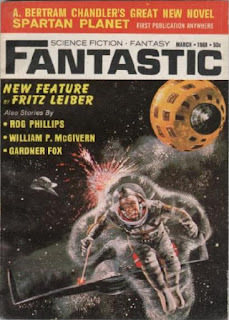 For a change of pace, I thought it might be enjoyable if this week's installment of Pulp Fantasy Library were instead an installment of Pulp Science Fiction Library. I've done this a few times in the past, though probably not often enough. Depending on how well this post is received, I might add more pulp sci-fi to the mix in future, since many of these writers and stories have a had huge influence on the early hobby, even beyond the realm of SF RPGs. Beyond that, I've always been more of a science fiction fan than a fantasy one, so this is a subject near and dear to my heart.
For a change of pace, I thought it might be enjoyable if this week's installment of Pulp Fantasy Library were instead an installment of Pulp Science Fiction Library. I've done this a few times in the past, though probably not often enough. Depending on how well this post is received, I might add more pulp sci-fi to the mix in future, since many of these writers and stories have a had huge influence on the early hobby, even beyond the realm of SF RPGs. Beyond that, I've always been more of a science fiction fan than a fantasy one, so this is a subject near and dear to my heart.The science fiction stories written by A. Bertram Chandler were significant influences on Traveller. Indeed, Chandler's most famous character, John Grimes, is in many ways an archetypal Traveller player character. He begins his career as lowly ensign in the Federation Survey Service, having many adventures along the way. He slowly rises up the ranks of the Service before taking up the life of an interstellar merchant, which leads to even more adventures. That's pretty close to the career trajectory of many Traveller PCs, the only difference being that Chandler devotes a great many stories to Grimes's time in the Service, rather than leaving those years as backstory.
"Spartan Planet" (as it was known in the USA; its original title was "False Fatherland" in Australia and New Zealand) is, in terms of publication, the second story of the now-Lieutenant Commander John Grimes. Split into two parts, it appeared in the March and May 1968 issues of Fantastic. The following year, it was be published complete as a novel by Dell and featured a cover by legendary illustrator John Berkey. I first read the story in a hardcover collection produced by the Science Fiction Book Club – remember that? – whose cover was done by another remarkable artist, Vincent DiFate.
The novel quickly introduces the reader to several characters, all of whom have names either directly taken from or inspired by Classical Greece: Achron, Brasidus, Heraklion, Telemachus. These characters, when speaking to one another, likewise make references to things normally associated with the ancient Mediterranean world, like Zeus, the Acropolis, or helots. Yet, it's also clear that, while the place where these characters dwell is called Sparta, it cannot be that Sparta or indeed anywhere in Greece. For one, there are references to wristwatches, the Air Navy, and even spaceships. Beyond that, there's something decidedly strange about these Spartans, namely, they reproduce by budding – or, rather, they did in the past, until advanced medical technology was developed that could handle this messy process instead.
Brasidus is a police officer by profession and the viewpoint character of "Spartan Planet," which took me by surprise. When I first read the story, I assumed that John Grimes would be the story's protagonist. Rather, Grimes does not enter the story until Chapter 4, when his starship, the Seeker III, lands at Sparta's spaceport, to which Brasidus had been sent. The spaceport rarely received starships and, when they did, they were one of two annually scheduled vessels that came bring and take cargo. The Seeker III was not one of these vessels and that was cause for concern, hence the need for Brasidus and the spaceport security officers to be present.
From out of this unexpected starship came two men, the first of whom is formally dressed in some kind of uniform – John Grimes, we soon learn.
Another man came out of the airlock, followed the first one to the ground. He, although his uniform was similar, was dressed more sensibly, with a knee-length black kilt instead of the constricting trousers.
But was it a man, or was it some kind of alien? Brasidus once again recalled those imaginative stories, and the assumptions made by some writers that natives of worlds with thin atmospheres would run to abnormal (by Spartan standards) lung development. This being, then, could be deformed, or a mutant, or an alien. Somebody muttered, "What an odd-looking creature!"
[…] Allow me to introduce myself. I am Lieutenant Commander John Grimes, Interstellar Federation Survey Service. This lady is Doctor Margaret Lazenby, our ethnologist …"
Lady, thought Brasidus. Then he must be a member of some other race. The Ladies? I wonder where they come from …
The Spartans are an all-male colony, one settled long ago, and for whom all knowledge of the existence of the female of the species has been lost – or, as events eventually reveal, hidden. The arrival of Grimes and especially Margaret Lazenby sets off a historical and cultural bomb on Sparta that has wide ranging consequences.
"Spartan Planet" is an odd story, both in terms of its structure and its content. As I stated above, Grimes is present and plays a very important role in the story, but it's Brasidus who is the novel's focal character. Though surprising, it does make narrative sense, since it's his worldview that is tested by the revelations that the crew of the Seeker III inadvertently bring to Sparta. This is the central conflict of the tale and I suspect one's enjoyment of it hinges on what you think of Chandler's portrayal of an all-male society loosely modeled on an idealized vision of ancient Greece. For myself, I don't completely buy into it, but I nevertheless find the clash of cultures compelling, particularly since Chandler makes an effort to show us the Spartans' perspective on their own history and society. Even with its shortcomings, that's the kind of science fiction I've long enjoyed.
April 22, 2022
King Arthur's Knights
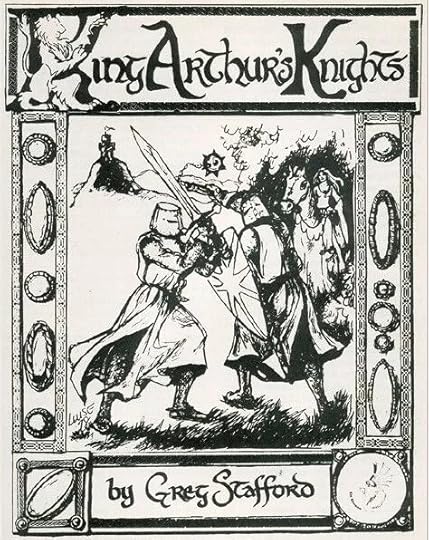 Looks like it's time to add another Arthurian game to the list of those I never owned. In this case, I never even heard of it. In fact, I can't even recall seeing any evidence of its existence in the Chaosium catalogs that came in the company's boxed sets during the early 1980s (or I somehow missed it).
Looks like it's time to add another Arthurian game to the list of those I never owned. In this case, I never even heard of it. In fact, I can't even recall seeing any evidence of its existence in the Chaosium catalogs that came in the company's boxed sets during the early 1980s (or I somehow missed it). In any case, it seems that Greg Stafford designed a competitive boardgame based around the legends of King Arthur and the Knights of the Round Table, which was published in 1978. Does anyone reading this reading post own or, alternately, has anyone ever played it? I'm curious to know a bit more about it, particularly the extent to which it has any design similarities to Pendragon.
April 21, 2022
Once There Was a Spot
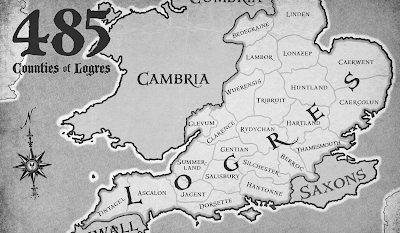 About two weeks ago, I asked readers to comment on roleplaying games they'd never played but wished they had. The responses were quite interesting and I'd like to thank everyone who took the time to comment on the post. Reading through them, one of the RPGs that was among the most commonly mentioned was Chaosium's Pendragon. Seeing the name of Greg Stafford's masterpiece mentioned so often warmed my heart. I'm incredibly fond of the game and am currently a player in a Pendragon campaign that's been running for more than a year now. However, I must admit that I often wonder how well known the game is outside of the circles in which I move. I'm generally of the opinion that Pendragon deserves to be better known, since it's one of a handful of roleplaying games I'd judge to be "perfect."
About two weeks ago, I asked readers to comment on roleplaying games they'd never played but wished they had. The responses were quite interesting and I'd like to thank everyone who took the time to comment on the post. Reading through them, one of the RPGs that was among the most commonly mentioned was Chaosium's Pendragon. Seeing the name of Greg Stafford's masterpiece mentioned so often warmed my heart. I'm incredibly fond of the game and am currently a player in a Pendragon campaign that's been running for more than a year now. However, I must admit that I often wonder how well known the game is outside of the circles in which I move. I'm generally of the opinion that Pendragon deserves to be better known, since it's one of a handful of roleplaying games I'd judge to be "perfect."I'm not being hyperbolic when I call Pendragon perfect. I have a couple of good reasons to think this, reasons that have the benefit of having been repeatedly put to the test in multiple campaigns I've refereed or played in over the decades since the games original release in 1985. The first is straightforward: its rules are simple yet evocative. More than that, they actively encourage players to get into the mindset of Arthurian legendary characters – and do so without the necessity of having to engage in amateur thespianism. The personality traits and passions system really does make it easier for players to get into their characters' heads in a way that leads to play reminiscent of what you read in Malory.
The second – and more substantial – reason I call Pendragon perfect is its built-in campaign structure. I've been harping on the joys of long campaigns since I returned to this blog almost two years ago. In discussing this matter with others, a common objection is that it's "too hard" to keep a campaign going for years on end, for both creative and logistical reasons. While I don't believe this is true (obviously), I do understand why someone who hadn't successfully been involved in a long campaign might think it was. That's the beauty of Pendragon: the game already does a lot of the heavy lifting for you. The rulebook provides a complete outline of decades of in-game events, from the end of Uther's reign to the fall of the death of Arthur. This is more than enough scaffolding for even a novice referee to build a sprawling, multi-generational campaign that would take, literally, years to complete, especially if you include the additional detail of supplements like The Boy King.
Pendragon assumes that player knights will undertake only a single significant adventure during the course of a year. The game's use of "adventure" is similar to that used by Malory in Le Morte d'Arthur, meaning a major event or confrontation. When combined with the timeline of Arthur's reign the game outlines, the referee is easily able to set events in motion, with the characters providing additional momentum through their own actions, choices, and alliances. As the knights marry, have children, assume greater responsibilities, and eventually die, there's plenty of scope for all manner of drama and intrigue. After a few game years, a Pendragon campaign practically runs itself, making it an ideal vehicle for referees with little experience of long campaigns.
As I said, I'm currently playing in a Pendragon campaign and having a great deal of fun. My first knight. Sir Adtherp, is nearly 40 years old now, having served first the Earl of Salisbury and then Arthur for close to two decades. He has several sons but none are yet old enough to replace him, so I expect, barring an unexpected turn of events, I'll be playing him for several more game years at least. On the other hand, if events should claim Adtherp's life, he has brothers whom I could play until Adtherp's sons come of age, or else I could create a new character entirely. Things are always happening in the campaign, which is humming along quite nicely, thanks in no small part to the remarkable design of the game itself, which is why I never cease to sing Pendragon's praises.
April 20, 2022
Retrospective: Snakepipe Hollow
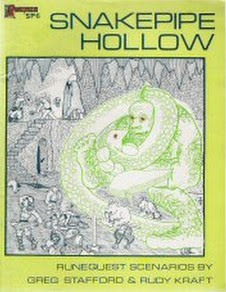 The modern roleplaying game was born in the dungeon and the earliest RPG campaigns revolved around exploring them.
The modern roleplaying game was born in the dungeon and the earliest RPG campaigns revolved around exploring them.
For those of us interested in the history of the hobby, it's therefore something of a tragedy that none of those "tent pole" dungeons, like Castles Blackmoor or Greyhawk, ever properly saw print. Instead, what we got were smaller, more focused dungeons intended for limited use (which makes sense, since, in most cases, they originated in the nascent tournament scene). While many of these published dungeons are excellent and indeed iconic, very few of them are suitable for long-term play, particularly when compared to the founding dungeons of the hobby.
I mention all of this because I've lately been doing a deep dive into the early years of Chaosium's RuneQuest, with an eye toward trying to put my finger on why I much prefer its portrayal of Glorantha to that of contemporary RQ. An important piece of that puzzle lies in Snakepipe Hollow, a collection of adventures written by Greg Stafford and Rudy Kraft and first published in 1979. Its title refers to a region of Dragon Pass that's home to the three levels of the Caves of Chaos (no, not those Caves of Chaos, even though they also first appeared in 1979), inhabited by all manner of inimical beings, such as ogres, scorpion men, and broos, among many more.
At the start of the book, Greg Stafford pens a remarkable introduction, in which he explains the origins and purpose of both Snakepipe Hollow the product and Snakepipe Hollow the place within Glorantha. For that reason, I'm going to reproduce it in full here:
This scenario pack provides a setting, motivation, and cast of friendly and hostile characters for the referee needing or desiring to construct a RuneQuest adventure on short notice, or for the readers interested in Dragon Pass as a place for active fantasy.
This book presents a unique section of Dragon Pass geography in some detail. This form presents this material in the same way as we prepared and ran it in our own campaign; we believe it will fit well into many different FRP campaigns.
There are several scenario suggestions, including appropriate NPC (non-player character) stats, which offer opportunities for people to enter this wild and dangerous region. These may take them to a part or all of the sections here. Referees are urged to make up their own as well.
The scenarios are not specifically designed for any number or quality of player characters. However, due to the nature of the region, we suggest that there be a good healthy mix of types, with parties numbering six to ten player characters with NPCs tossed in to provide play balance where necessary.
This pack is designed for repeated play. It contains one wilderness and three interior maps, almost 200 monster stats and over 25,000 words of description presented in a modular and flexible format.
GOOD LUCK!
There are two points that stand out to me. First, Stafford states clearly that the material in Snakepipe Hollow derives from his home campaign and that it's presented "in the same way as we prepared and ran it." I take that to mean that it's not been notably altered from what he used with his own players. Second, he emphasizes that "this pack is designed for repeated play." Thus, this is not a one-and-done product, but instead something that's able to hold the players' attentions for an extended period of time.
Viewed from a certain perspective, Snakepipe Hollow starts to sound, to me at any rate, as if it's another example of an early tent pole dungeon. I won't go so far as to call it a megadungeon, since there are fewer than 60 keyed locations within the Caves of Chaos. Further, I don't believe that a dungeon need be "mega" in extent to qualify as a long-term campaign focus, but that's a topic for another post. Nevertheless, I think a reasonably good case could be made that Snakepipe Hollow possesses the level of depth and complexity needed to occupy the center of an entire campaign, especially when one remembers that the Caves of Chaos sit within a larger wilderness area that is every bit as treacherous – and rewarding – as they are.
If I could refer to Stafford's introduction just one more time, I'd like to note that he calls Snakepipe Hollow a "scenario pack." That's yet another bit of evidence in support of the idea that the Caves of Chaos and the area around it was imagined not just "as a place for active fantasy" – what an evocative turn of phrase! – but as the focus of weeks or months of regular play. In addition to keys for the wilderness and the Caves, Snakepipe Hollow presents multiple potential NPC patrons, groups, rumors, and "help wanted" notices, all of which provide the player characters with reasons for venturing into the Hollow beyond mere treasure hunting. This is not just useful; it's vital, since it'll help frame the characters' expeditions within the context of the larger world, which is exactly what's needed to keep a campaign humming along indefinitely.
Since I was never a player of RuneQuest back in my youth, Snakepipe Hollow is, frankly, revelatory in the way it suggests that the hobby's early emphasis on tent pole dungeons was still alive and well, even in California. More significant still is that the Caves of Chaos and their surrounds may be one of the few published examples of those early campaign dungeons. If so, I think Snakepipe Hollow needs to be more widely known and studied than it seems to be. I know I'll be spending a lot more time with it in the weeks to come.
April 19, 2022
White Dwarf: Issue #34
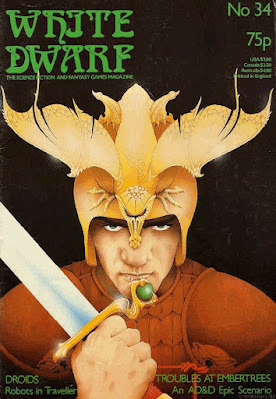 Issue #34 of White Dwarf (October 1982) features a cover by Emmanuel, the artist responsible for the cover of the Fiend Folio. Although it's a very simple piece in terms of composition, I've always been quite taken with it. Almost as interesting is the fact that the cover describes the issue's AD&D adventure, "Troubles at Embertrees," as "epic." Such hyperbolic language is commonplace nowadays, but I was rather surprised to see it used here. I'll have a little more to say on this topic when we look at the adventure in question.
Issue #34 of White Dwarf (October 1982) features a cover by Emmanuel, the artist responsible for the cover of the Fiend Folio. Although it's a very simple piece in terms of composition, I've always been quite taken with it. Almost as interesting is the fact that the cover describes the issue's AD&D adventure, "Troubles at Embertrees," as "epic." Such hyperbolic language is commonplace nowadays, but I was rather surprised to see it used here. I'll have a little more to say on this topic when we look at the adventure in question."Droids" by Andy Slack is yet another attempt to provide rules for robots in Traveller, which somewhat inexplicably lacked them (and wouldn't get official rules for them until 1986). Unlike many such articles, Slack doesn't present a system for creating robots patterned after the rules for starship construction (or vehicles in Striker). Instead, he simply offers up many examples of robot models, such as robodocs, valet droids, and guardbots. It's a reasonable approach and one I personally like, since I've rarely cared much for "build-your-own" systems, though I imagine it would be something of a disappointment for the gearheads that Traveller tends to attract.
"Space Invader" by Mike Costello is a brief article discussing the pros and cons of purchasing a "microcomputer," as personal computers were sometimes called back then, for use with RPGs. The article is mostly of interest as a historical artifact from the dawn of the PC era. On many levels, the same can be said of Part I of Lewis Pulsipher's "A Guide to Dungeon Mastering." In this article, Pulsipher covers many well-worn topics about how to create and set up adventures. While most of his advice is solid, I don't think any of it would come as a surprise to referees today, since what he says had long since passed into the realm of conventional wisdom. That's no knock against the article, only an acknowledgment that there's been a lot of water under the bridge in the last four years (!).
"Open Box" reviews three RPG products, starting with Cults of Terror for RuneQuest, which receives a rating of only 6 out of 10. Why it's judged relatively harshly is unclear from the review, since the reviewer calls it "tremendous stuff." Meanwhile, FGU's Aftermath! is given 10 out of 10, albeit by a different reviewer, and even I, a fan of the game, think that's a bit much. Finally, Chaosium's Worlds of Wonder receives 7 out of 10; this seems fair, given that three included games are more "skeletons" than fully-fleshed out systems. "Runebeasts" presents two new monsters for use with RuneQuest, in this case the humanoid pterodactyls known as the Vrak and the Nachak, weasel-like beings associated with the Darkness and Disorder runes.
"Trouble at Embertrees" by Paul Vernon is a lengthy introductory scenario for use with AD&D characters of levels 1–2. Like so many White Dwarf scenarios, this one is presented in tiny, dense type and is filled with loads of details, some of them quite extraneous to the actual play of the adventure. The basic set-up is that the characters are hired by a woodcarver who wants them to investigate rumors of strange goings-on at Embertrees, a remote village named after the magical Embertree that grows nearby. Once at Embertrees, the characters are thrown into a mess of conflicting factions, allegiances, and secrets, all presented in a way I found both intriguing and downright confusing. I think there's a good adventure here, buried under all the detail, but it's hard to determine, based on its organization (or, rather, lack thereof). Whether it deserves to be touted as "epic," I can't rightly say, but there can be little doubt that there's a lot here for the referee to wade through before he even thinks of running it.
"Morality in Traveller" is an odd little article by Bob McWilliams in which the author is reacting to the apparent fact that many Traveller characters behave badly in adventures and campaigns, owing in part to the game's lack of a morality/alignment system à la D&D. It's a very strange thing to say in my opinion, but then I rarely had to deal with the kind of amoral behavior McWilliams alludes to. Duncan Bisatt's "The Mahwrs" introduces a bat-like alien race for use with Traveller – nothing to write home about in my opinion.
"Fiend Factory" this months focuses on "More Dead than Alive," meaning five new types of undead or undead-like creatures. I'm a sucker for new undead, so I enjoyed this article more than I expected. Finally, "Treasure Chest" details five new magical weapons, another favorite topic of mine, though I can't say any of the five detailed here are stand outs.
This is another solid, workmanlike issue, though, with the exception of "Trouble at Embertrees," of whose actual value I am still not certain, most of its contents are utterly ephemeral. I don't mean to be harsh; that is the nature of periodicals, after all, even ones as storied as White Dwarf. Still, I will confess to some small disappointment that issue #34 was not as memorable as its immediate predecessors.
April 18, 2022
Pulp Fantasy Library: The Shadow over Innsmouth
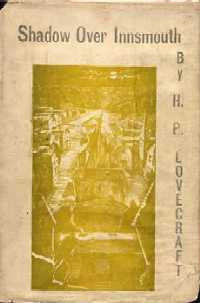 Over the past couple of weeks, I've been simultaneously reading (or, rather, re-reading) S.T. Joshi's magisterial, two-volume biography of the Old Gent, I Am Providence: The Life and Times of H.P. Lovecraft and Michel Houellebecq's brief but oddly compelling H.P. Lovecraft: Against the World, Against Life. While the two authors don't agree about much where Lovecraft is concerned, they both regard the novella,
The Shadow over Innsmouth
, as very close to the pinnacle of HPL's literary output.
Over the past couple of weeks, I've been simultaneously reading (or, rather, re-reading) S.T. Joshi's magisterial, two-volume biography of the Old Gent, I Am Providence: The Life and Times of H.P. Lovecraft and Michel Houellebecq's brief but oddly compelling H.P. Lovecraft: Against the World, Against Life. While the two authors don't agree about much where Lovecraft is concerned, they both regard the novella,
The Shadow over Innsmouth
, as very close to the pinnacle of HPL's literary output. There are multiple historical ironies to this assessment, starting with the fact that Lovecraft himself didn't think much of the story. In a 1931 letter to August Derleth, he claimed it "has all the defects I deplore" and that, as a result, he didn't intend to offer it for publication "for it would stand no chance of acceptance." In this, Lovecraft was at least partly correct. When Derleth surreptitiously sent a copy of Innsmouth to Weird Tales – something he had done before – editor Farnsworth Wright did indeed reject it, largely on the grounds that it was "too long to run complete in one part."
Later, a correspondent of Lovecraft, William L. Crawford, had founded a small press through which he hoped to publish the works of some of the best writers of Weird Tales, including HPL. Crawford was very interested in The Shadow over Innsmouth, because it had not yet appeared in print anywhere else. Were he to publish it himself, it would be quite the literary coup, or so Crawford hoped. Though the book appeared in 1936 – the only book bearing Lovecraft's byline to appear while he was still alive – it sold poorly and Crawford ultimately withdrew from his grandiose publishing plans for nearly a decade afterwards.
Nevertheless, The Shadow over Innsmouth remains one of Lovecraft's most well known and celebrated works and justifiably so. The novella tells the story of an unnamed narrator who had decided to celebrate his coming of age by taking a tour of New England for "sightseeing, antiquarian, and genealogical" purposes. His ultimate destination is Arkham "whence [his] mother's family derived." However, because he cannot afford to take a train directly to Arkham, he elects instead to take a bus to Innsmouth, a town to the north and one previously unknown to him.
While waiting for the bus to arrive, the narrator learns a little of the history of Innsmouth and its people. Prior to the middle of 19th century, Innsmouth had been a thriving seaport. Then, an epidemic of mysterious origin killed half of its inhabitants and it entered into decline. Now, the main business that thrives is the Marsh refinery, run by "Old Man Marsh," grandson of Captain Obed Marsh, who had traveled extensively in the Pacific and married "some kind of foreigner – they say a South Sea islander." Innsmouth also boasts some fishermen as well, who ply their trade near the Devil's Reef off the coast.
The narrator also learns that outsiders avoid not just Innsmouth itself but its inhabitants on account of their strange appearance.
There certainly is a strange kind of streak in the Innsmouth folks today – I don't know how to explain it, but it sort of makes you crawl … Some of 'em have queer narrow heads with flat noses and bulgy, stary eyes that never seem to shut, and their skin ain't quite right. Rough and scabby, and the sides of their necks are all shrivelled and creased up. Get bald, too, very young. The older fellows looks the worst – fact is, I don't believe I've ever seen a very old chap of that kind. Guess they must die of looking in the glass! Animals hate 'em – they used to have lots of horse trouble before autos came in.
Despite this, the narrator takes the bus to Innsmouth and begins exploring the seaside town. He soon discovers it to be a place in the process of slow decay, its buildings poorly maintained and dilapidated and its people, most of whom match the description cited above, appearing even more degenerate to his eyes. Worse, the local eye him with suspicion and he begins to think it might be best if he were to leave Innsmouth sooner rather than later.
It's at this point that he stumbles upon Zadok Allen, who was "ninety-six years old and touched in the head." Allen, he had been told by one of the few friendly people he'd met in Innsmouth, was a useful font of information about the place and its history and "was unable to resist any offer of his favorite poison; and once drunk would furnish the most astonishing fragments of whispered reminiscence." And so he does. Plied with liquor, Allen tells the narrator about Captain Obed Marsh and his dealings with the Kanak islanders.
"Wal, Sir, Obed he larnt that they's things on this arth as most folks never heerd about – an' wouldn't believe ef they did hear. It seems these Kanakys was sacrificin' heaps o' their young men an' maidens to some kind o' god-things that lived under the sea, an' gettin' all kinds o' favours in return. They met the things in the little islet with queer ruins, an' it seems them awful picters o' frog-fish monsters was supposed to be picters o' these things. Mebbe they was the kind o' critters as got all the mermaid stories started. They had all kinds o' cities on the sea-bottom, an' this island was heaved up from thar.
These are the Deep Ones, one of Lovecraft's most famous creations and, according to Allen, Captain Marsh had made a deal with them. He would provide them with a steady supply of human sacrifices and they would provide him – and Innsmouth – with an equally study supply of fish and gold dredged up from the sea. In addition, by mating with them, the people of Innsmouth would slowly acquire the characteristics of the Deep Ones and "wouldn't never die," in Allen's words. To this, he adds
"Git aout o' here! Git aout o' here! They seen us – git aout fer your life! Dun't wait fer nothin' – they know naow – Run fer it – quick – aout o' this taown –"
Though the narrator is not wholly convinced by Allen's hysterical warning, he is nevertheless unnerved by what he has heard. He resolves to leave Innsmouth as soon as possible, just as he had planned before meeting the drunken old man. It's then that the final act of the novella begins, as the narrator comes to understand just how much Allen had told him is true – and how immediately relevant it is to his recent desire to travel to New England and see the places from which his mother's family came …
The Shadow over Innsmouth is indeed one of Lovecraft's greatest works, just as Innsmouth itself is one of his most frightfully realized locales. The aura of decay and decline is palpable. More than that, the story, though ostensibly focused solely on the experiences of the unnamed narrator, expertly conveys the connection between the mundane and the cosmic. What the narrator learns over the course of the novella is extremely personal and yer that knowledge has larger implications that are, in my opinion, among the most chilling in all of Lovecraft's works. The Shadow over Innsmouth is a masterpiece; anyone with even the slightest interest in HPL should take the time to read it, if they haven't already done so – and those who already have should consider doing so again.
April 14, 2022
Retrospective: The Assassin's Knot
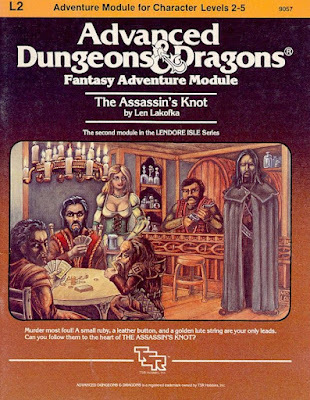 My appreciation for The Secret of Bone Hill is well known. Alongside The Village of Hommlet, I consider it one of the best low-level adventure modules ever written for Dungeons & Dragons, in large part because of the care author Len Lakofka took to establish its "home base," the village of Restenford. However, in both of the aforementioned modules, there's another important ingredient: the menace that lurks on the borders of the that home base. Without the Moathouse and the titular Bone Hill, I suspect my affection for these modules would diminish considerably, if not evaporate completely. I like both adventures because of the effective contrast between the sleepy outposts of civilization and the evil that threatens to overwhelm it.
My appreciation for The Secret of Bone Hill is well known. Alongside The Village of Hommlet, I consider it one of the best low-level adventure modules ever written for Dungeons & Dragons, in large part because of the care author Len Lakofka took to establish its "home base," the village of Restenford. However, in both of the aforementioned modules, there's another important ingredient: the menace that lurks on the borders of the that home base. Without the Moathouse and the titular Bone Hill, I suspect my affection for these modules would diminish considerably, if not evaporate completely. I like both adventures because of the effective contrast between the sleepy outposts of civilization and the evil that threatens to overwhelm it.
In The Assassin's Knot, Lakofka attempts to mine the same vein – to much more mixed results, in my opinion. First published in 1983, the module is a follow-up to The Secret of Bone Hill, starting with the fact that, like its predecessor, it takes place on Lendore Isle in the World of Greyhawk. More importantly, the ultimate antagonist of the adventure is a character first introduced in Bone Hill (where his eventual villainy was explicitly mentioned, the consequences of which would appear in a future adventure, namely this one). Nevertheless, The Assassin's Knot can stand more or less on its own.
The bulk of the scenario takes place in another little town, the implausibly named Garroten. Like Restenford, Lakofka lavishes much detail on this settlement and its inhabitants. We meet Gelmark and Lydia, a pair of retired adventurers who married and settled down to run the general store. We also meet Krak, the half-orc armorer who's sometimes possessed by an evil sword he acquired some time ago, as well as many more characters, each with their own personalities, quirks, and backstories. Most are genuinely well done and it would be very easy for a referee to spin this information into many more adventures. This is where The Assassin's Knot excels and why I still have a soft spot for it.
However, the main action of the module is not as well done. As its title might suggest, The Assassin's Knot concerns the assassination (by strangulation) of Baron Grellus of Restenford. Clues left at the scene of his murder point toward the town of Garroten – you see what I mean about the town's infelicitous name? – and the characters are tasked with discovering the identity of the murderer and bringing him to justice. On the surface, this all sounds compelling. As most experienced referees no doubt know, murder mysteries are a lot more difficult to execute successfully than they might seem and it's rare that published adventure modules do this well. There are simply too many ways that things can go of the rails, which is a recipe for frustration and disappointment for the players.
That said, Lakofka makes a good effort at trying to obviate the most apparent stumbling blocks, starting with information presentation. He provides the referee with a clear summary of who did what when, in addition to their motivations. Thus, the referee is in a good position to handle the characters' investigation of the baron's murder. Unfortunately, the murder itself was motivated by insanity, which makes it much harder for anyone attempting to make sense of it. The matter isn't helped by the fact that the assassin who perpetrated the crime is, in turn, planning to double-cross his patron, thereby creating more contradictory information for the characters to sift. The end result is something of a chaotic muddle, despite Lakofka's best efforts to make things clear.
In the end, I view The Assassin's Knot as a failed experiment – or perhaps, if one is more charitable, a partially successful one. Garroten, its name to the contrary, is nicely imagined place filled with interesting NPCs. Likewise, the module as a whole is notable for not including a single dungeon. Instead, its text is entirely given over to providing clues, information, and NPCs with which to interact. It's an important departure from earlier D&D modules and it's for that reason that I look on it with more fondness than it might otherwise engender. It's not perfect by any means, but it gets a lot of points for effort.
April 10, 2022
Pulp Fantasy Library: The Last Enchantment
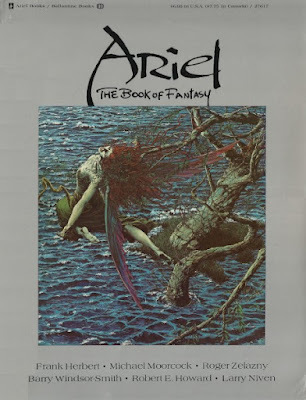 Though the character of Elric of Melniboné is perhaps best known from the novelettes and novellas in which he appears, like "The Dreaming City," Michael Moorcock also penned numerous shorter works featuring the last emperor of the Bright Empire. One of my favorites is "The Last Enchantment," which was first published in the pages of Ariel: The Book of Fantasy: Volume Three in October 1978 and later included in several different collections (which is where I read it). Though this was its first published appearance, Moorcock had actually written it almost two decades earlier, in 1962, at which time it bore the title "Jesting with Chaos" – a much more apt title in my opinion. Consequently, in terms of its conception, it harkens back to the early days of Moorcock's writing about Elric, which may well explain its appeal to me.
Though the character of Elric of Melniboné is perhaps best known from the novelettes and novellas in which he appears, like "The Dreaming City," Michael Moorcock also penned numerous shorter works featuring the last emperor of the Bright Empire. One of my favorites is "The Last Enchantment," which was first published in the pages of Ariel: The Book of Fantasy: Volume Three in October 1978 and later included in several different collections (which is where I read it). Though this was its first published appearance, Moorcock had actually written it almost two decades earlier, in 1962, at which time it bore the title "Jesting with Chaos" – a much more apt title in my opinion. Consequently, in terms of its conception, it harkens back to the early days of Moorcock's writing about Elric, which may well explain its appeal to me.The tale begins as "a shuddering man … his bloated eyes full of blood" is running through a dark forest, clutching "a glowing black talisman" in his hand and muttering to himself. The reader soon learns that the man is named Slorg and that the strange talisman he carries enables him to speak with a disembodied being called Teshwan. It's then that Elric enters the story, riding through the very same forest.
The horseman's long, sharply delineated skull was leper-white, as if stripped of flesh, and his slightly slanting eyes gleamed crimson. He wore a jerkin of black velvet caught at the throat by a thin silver chain. His britches, too, were of black cloth, and his leather boots were high and shining. Over his shoulders was a high-collared cape of scarlet and a heavy longsword slapped at his side as he pulled his steed to a standstill. His long, flowing hair was as white as his face. The horseman was an albino.Elric comes across Slorg, who begs him to aid him against the Hungry Whisperers, demonic beings who dog his trail. "Now why should I, my friend? Tell me that." Elric replies. Slorg then explains – or tries to explain – that he has been "profaned," but Elric quickly tells him that this is "none of my business." This doesn't sit well with Slorg, who becomes angry and tells the wandering Melnibonéan that, though he was "a man no longer," he was nevertheless "Siletah Slorg – Siletah of Oberlorn," a title that means nothing to Elric.
Elric, in turn, introduces himself and this elicits a reaction from Slorg, who calls him an "outcast." He then asks Elric again for aid. "Help me and I will tell you secrets – such secrets!" Elric remains disinterested and bids Slorg farewell. The strange man then threatens the Melnibonéan with his talisman's "last enchantment" if he does not do as he asks. When Elric urges his horse onward instead, Slorg calls upon Teshwan to perform "a deed of vengeance" against him.
Not long afterward, Elric finds himself transported to "a vast and lonely expanse of flat, grey stone" that he suspects is another world, one ruled completely by the Lords of Chaos, of whom Teshwan was undoubtedly one. Worse than that, his mighty runesword, Stormbringer, is dead.
Normally the blade, forged by unhuman smith for Elric's royal ancestors, was alive with sentience – throbbing with the life-force it had stolen from a hundred men and women whom Elric had slain. Once before it had been like this – in the Caverns of Chaos long ago.
Elric tightened his lips, then shrugged as he replaced the sword in its scabbard.
"In a world completely dominated by the forces of Chaos," he said, "I cannot rely on the powers which normally aid me in my sorcery. Thank Arioch I have a good supply of drugs about me, or I would indeed be doomed."
Elric presses forward and encounters another traveler, a man "dressed in green, a silver sword dangling in his right hand." The man tells Elric that he travels "to Kaneloon, for the Rites." The Rites, it seems, are performed by the Lords of Chaos to reform the world "into a fresh variety of patterns." Hearing this, he asks the man if there might be some way he could leave this realm of Chaos. The man suggests visiting the palace of Kaneloon. There, he might be able to convince the Lords to return him to his own world – or not, since "the Lords of Chaos are fickle." The man then disappears.
Elric makes his way to the palace and is given entrance by the guardian giant, who tells him that
"My masters order me to inform you that you may enter but that, having once come to the Palace of Kaneloon, you may never leave save under certain conditions."
"Those conditions?"
"Of these they will tell you if you enter. Are you reckless – or will you stand pondering?"
"I'll avail myself of their generosity," smiled Elric and spurred his nervous horse forward.
The remainder of the story details Elric's meeting with the Lords of Chaos, including Teshwan, whom Slorg beseeched to exact his revenge on the Melnibonéan. He must confront them and the aforementioned condition in order to return home: "You may leave only if you can create something which it has never occurred to us to create."
"The Last Enchantment" is short and evocative. Not only is the reader treated to seeing Elric attempt to outwit the Lords of Chaos to save himself, but we get to something of the nature of these mysterious beings and their role in the multiverse. It's fascinating, even thought provoking stuff, made all the more enjoyable because Moorcock keeps his philosophizing on a short leash. The story is not over-indulgent and Elric, despite his exile, does not much yield to his signature melancholy. Instead, we get tight, clever tale of almost mythological character, in which a mortal contends with godlike beings – and wins.
April 8, 2022
Games You've Never Played – But Wish You Had
I regularly hear it boasted that there are now more roleplaying games available than at any time in the hobby's history. That's almost certainly true, though it's a very odd boasted, given that I don't think most gamers ever get the chance to play more than a small number of them (or, if they do, they can't possibly play them for very long). Mind you, this was true even back in the first decade of the hobby and I can distinctly recall seeing or hearing about many RPGs I never had the chance to play myself.
This got me to thinking: what is the one roleplaying game that I've never played but wish I had? I thought about this question for a while and considered several possible answers before settling on an answer that satisfies me: Space Opera. Though I am a devoted fan of science fiction roleplaying games (and even wrote one myself), I've never played FGU's 1980 entry into the genre. I own a lot of the game's releases and have read several of them avidly, but, more than four decades later, I've never never succeeded in playing the game, though I did come close a few years ago.
I suspect the main reason I never played Space Opera back in the day is that I already owned Traveller, Star Frontiers, and Star Trek. Between them, I had more than enough options to sate my appetite for sci-fi. More to the point, aside from a couple of guys I met a public library games day, I didn't know anyone who played Space Opera regularly, which made it less likely I'd ever do so. But I always wanted to play the game, in large part because it was such a delightful mishmash of elements ripped bleeding from the bodies of popular science fiction books, tv shows, and movies that I suspect it would have been a blast to play. Honestly, I still think that, even if I remain somewhat skeptical of its rules.
What about you? What one roleplaying game have you never played but wish you had? Non-existent bonus point if you explain why you've never played it and/or why you wish it were otherwise?
April 7, 2022
Best Wishes
Issue #49 (May 1981) of Dragon includes an article entitled "Best Wishes!" by Gary Snyder. The article, as its title suggests, discusses the contentious topic of magic wishes in Dungeons & Dragons, with an eye toward providing guidelines to aid the referee in adjudicating them. Snyder then proposes ten "general principles" toward this end, reproduced here.
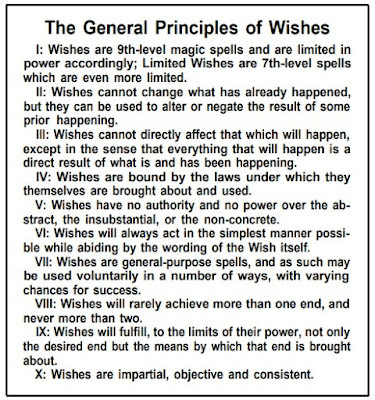 I find it difficult to disagree outright with any of the principles above, which, for the most part, strike me as eminently sensible. At the same time, I can't be bothered to care. I have long felt that the only important question the referee needs to ask himself regarding magic wishes is whether or not to allow them in his campaign in the first place. If he does, fencing in their efficacy with so many caveats, conditions, and provisos strikes me as missing the point of magic wishes in the first place, namely, they can do anything.
I find it difficult to disagree outright with any of the principles above, which, for the most part, strike me as eminently sensible. At the same time, I can't be bothered to care. I have long felt that the only important question the referee needs to ask himself regarding magic wishes is whether or not to allow them in his campaign in the first place. If he does, fencing in their efficacy with so many caveats, conditions, and provisos strikes me as missing the point of magic wishes in the first place, namely, they can do anything.
Now, I fully appreciate that how potentially destabilizing putting that kind of power into the hands of players could be. After all, clever players already have a nasty habit of upending the referee's best laid plans; give them the literal ability to alter reality with a word and who knows the mischief of which they're capable? If a referee feels that way – and there's absolutely no shame in this – then simply don't allow magic wishes. Eviscerating them to the point where they can scarcely do anything with far-reaching consequences suggests to me the referee doesn't really want them in his campaign anyway. Why not be honest about that?
On the other hand, if you do elect to include them in your campaign, I recommend you allow them to be fully efficacious. This is not to say that magic wishes should not have consequences, even unpleasant ones. Volume 2 of OD&D, for example, counsels the referee to use "utmost discretion" when handling wishes and then offers suffer examples of ways to turn a player's own greed against him through creative interpretations of his wish. AD&D (in both editions) includes similar advice and I imagine it's through the influence of passages like these that I've never really felt the need to rein in the potency of magic wishes.
If anything, I relish the opportunity to present players with magic wishes, who know full well that W.W. Jacobs is never far from my mind and act accordingly. Wishes are an occasion of a strange battle of ingenuity between not just the players and myself but also within the players' own minds. They carefully ponder the matter, attempting to find the best way to get as much as they think I'll allow before they trigger my desire to twist their words to their detriment. Believe it or not, it's fun, for both the players and myself and probably goes some way to explain why I've never felt the need for "general principles" like Snyder's.
I suppose my real point is that, too often, referees judge how much a rule or aspect of the game as written might "unbalance" their campaigns before they've been given a fair shake. My own experience has taught me that, when it doubt, it's best to assume "D&D is always right," which is to say, that it's usually wiser to stick with the game as it exists until play demonstrates that some rule or aspect of it actually doesn't work well. In other words, try to play the game as it is rather than how you'd prefer it to be, based on some idealized notion of what the game should be. I don't say this to discourage house ruling, which has a long and storied history in the hobby, only to encourage my fellow referees not to worry so much about how magic wishes (or anything else) might "ruin" their campaigns if not confined by all sorts of before-the-fact limitations. Let D&D be D&D – including magic wishes.
https://reparrishcomics.com/post/188710803838/facebook-twitter-instagram-redbubble-buy
James Maliszewski's Blog
- James Maliszewski's profile
- 3 followers



